La formation d'un nouveau chiot peut être un processus incroyablement difficile. Entre la formation à la maison et la formation au comportement, un nouveau chiot ressemble beaucoup à un travail à temps plein. Lorsque vous combinez cet emploi avec votre réel travail, vous aurez peut-être un besoin urgent de raccourcis. Sans oublier à quel point le processus peut être plus difficile si votre nouveau chien a un traumatisme passé qui le rend atypique - même quelque chose d'aussi simple qu'une personnalité particulièrement têtue peut compliquer les choses.
Si vous avez du mal à dresser votre chiot pour qu'il s'adapte à votre maison et à votre style de vie, vous êtes au bon endroit. Nous avons compilé une liste de 101 trucs et astuces pour entraîner votre chiot, couvrant tout, du cambriolage à l'entraînement à l'obéissance, à l'entraînement en caisse et aux coussinets d'entraînement pour chiots, ainsi que des liens vers les meilleures vidéos d'entraînement, guides, produits et tout ce dont vous avez besoin pour installez bien votre nouveau chiot dans votre style de vie et votre routine.
Dans cet article
Chiot d'apprentissage de la propreté
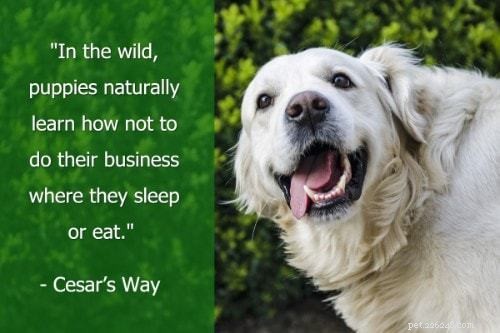
1. C'est naturel. « En théorie, cela ne devrait pas être si difficile. Dans la nature, les chiots apprennent naturellement à ne pas faire leurs besoins là où ils dorment ou mangent. Ils apprennent cela parce que leur mère garde la tanière propre, se débarrassant immédiatement de tous les dégâts que ses chiots font. Sans cette odeur, les chiots n'associent pas la zone à se soulager. – Apprentissage de la propreté d'un chiot , Chemin de César ; Twitter : @cesarmillan
2. Faites un horaire. «Ceci est essentiel au succès de la formation à la propreté. Les chiots ont de minuscules vessies et l'eau coule juste à travers elles. Il en est de même pour la matière solide. Entre. Sort. Vous devez vous assurer que vous donnez à votre chiot amplement l'occasion de faire ce qu'il faut. – Mara Bovsun, Comment apprendre à la propreté d'un chiot :un guide complet pour réussir , American Kennel Club; Twitter : @akcdoglovers
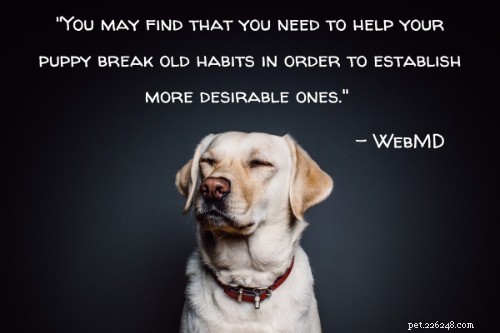
3. Ne vous attendez pas à l'impossible. "La première chose à comprendre est qu'un chiot n'a pas de contrôle sur les muscles d'élimination avant l'âge de quatre mois, et tous les chiots varient dans le temps de développement de ces muscles. Les petits chiens ont des vessies plus petites et auront besoin d'uriner plus fréquemment. – Estelle W., L'éducation des chiots :ce que vous devez savoir pour une effraction réussie , Animaux trouvés ; Gazouillement : @FoundAnimalsOrg
4. Ils sortent après chaque… "Emmenez-les dehors immédiatement après le réveil, pendant et après avoir joué, et après avoir mangé et bu." – Comment dresser un chiot à la maison, Endroit plus sûr pour les chiots ; Twitter : @SaferPups

5. Tenez compte de leurs arrangements précédents. « Les conditions de vie antérieures de votre chiot sont un autre prédicteur. Vous constaterez peut-être que vous devez aider votre chiot à briser ses vieilles habitudes afin d'en établir de plus souhaitables. – L'éducation à la maison de votre chiot , WebMD ; Gazouillement : @WebMD
6. La première semaine est la plus difficile. "La première semaine d'apprentissage de la propreté d'un chiot est fatigante, mais cela devient plus facile, je le promets. Vous pourriez vous demander pourquoi vous avez choisi un chiot pour commencer – croyez-moi, nous sommes tous passés par là. Mais après cette première semaine, ça va devenir plus facile. – Jen Gabbard, 5 conseils simples pour l'apprentissage de la propreté de votre chiot , Puppy Fuites; Twitter : @puppyleak

7. Rappelez-vous que les chiens ne sont pas des humains. "D'après mon expérience, l'une des principales raisons de l'échec de l'apprentissage de la propreté est que les parents de chiens ont tendance à considérer leurs compagnons canins comme des humains à quatre pattes. Ils voient les accidents d'animaux de compagnie sur le sol de la même manière qu'ils verraient une personne qui s'est soulagée sur le sol. Bien que votre chien soit un membre de votre famille, ce n'est pas une personne, et si vous gérez mal les erreurs de propreté dans la maison, vous obtiendrez très souvent le résultat opposé à celui que vous souhaitez et aggraverez la situation. – Dr. Karen Becker, Évitez cette erreur :contrecarrez presque toutes les tentatives de dressage de votre chiot , Animaux en bonne santé ; Twitter : @drkarenbecker
8. Utilisez des coussinets pour chiots "juste au cas où". "Bien que les coussinets pour chiots soient très utiles pour contenir ces inévitables petits dégâts au cours des premiers mois de la vie de votre chiot, vous ne voulez pas que votre chien développe l'habitude de les utiliser pour aller aux toilettes au lieu d'attendre qu'ils soient laissés. dehors. La meilleure façon d'éviter cela est de s'assurer que quelqu'un peut venir voir votre chien toutes les quelques heures environ pour les emmener dehors. De cette façon, les coussinets pour chiots ne sont qu'un complément à leur entraînement régulier à la propreté. - James Shore, Comment élever un chiot si vous travaillez à temps plein - Ce n'est pas impossible !, formation labrador; Twitter : @LabTrainingHQ

9. Demander de l'aide. « Si vous avez des amis de confiance ou des membres de votre famille qui possèdent des chiens ou qui sont bons avec les animaux, pensez à leur demander de l'aide. Essayez de réfléchir à la façon dont vous pouvez rendre l'arrangement pratique pour eux, comme amener votre chiot et ses nécessités chez eux avant le travail. Envisagez des moyens d'offrir des incitations et des avantages à votre ami qui garde son chien, surtout si vous ne le payez pas. Essayez de faire quelque chose que vous savez qu'ils apprécieraient, comme les emmener dîner ou faire une autre activité chaque semaine environ. – Comment prendre soin d'un chiot lorsque vous travaillez à temps plein , WikiComment ; Twitter : @wikiHow
10. Vous obtenez plus d'abeilles avec du miel. "Il n'y a qu'une seule méthodologie acceptable pour l'apprentissage de la propreté d'un chien de tout âge :le renforcement positif. Les conseils traditionnels suggéraient d'écraser un chien ou de se frotter le visage dans ses déchets pour des erreurs dans la maison, mais ces techniques ne font rien pour rendre le processus d'apprentissage de la propreté plus compréhensible pour votre chien et peuvent en fait nuire à votre relation avec lui. Gardez à l'esprit que les chiens ne voient pas leurs déchets comme nous - pour eux, faire pipi et caca est assez intéressant ! Punir votre chien pour être entré dans la maison ne l'aidera pas à comprendre ce qu'il devrait faire à la place et pourrait lui faire peur de s'approcher de vous, à l'intérieur ou à l'extérieur. Un apprentissage de la propreté réussi nécessite de la patience, de la gentillesse et se souvient que votre nouveau chiot apprend juste les règles. – Victoria Schade, Comment apprendre à la propreté de votre chien , PetMD; Gazouillement : @petMD
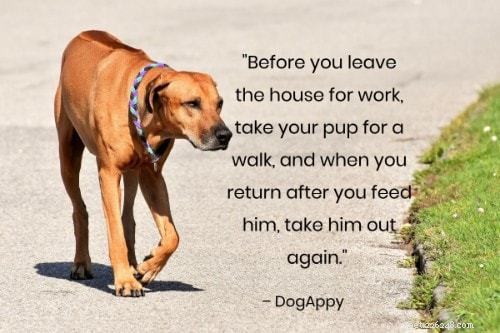
11. Avant de laisser votre chiot, préparez-le. "Avant de quitter la maison pour le travail, promenez votre chiot, et quand vous revenez après l'avoir nourri, sortez-le à nouveau." – Comment dresser un chiot lorsque vous travaillez toute la journée , DogAppy
12. Les accidents arrivent. « Les erreurs arrivent. Attendez-vous à ce que votre chiot ait quelques accidents dans la maison - c'est une partie normale de l'apprentissage de la propreté […] Ne punissez pas votre chiot pour avoir fait ses besoins dans la maison. Si vous trouvez une zone souillée, il est trop tard pour administrer une correction. Il suffit de le nettoyer. Frotter le nez de votre chiot dedans, l'amener sur place et le gronder ou toute autre punition ne fera que lui faire peur de vous ou peur d'éliminer en votre présence. La punition fera souvent plus de mal que de bien. – Comment éduquer votre chien ou votre chiot , La Humane Society des États-Unis d'Amérique; Twitter : @HumaneSociety
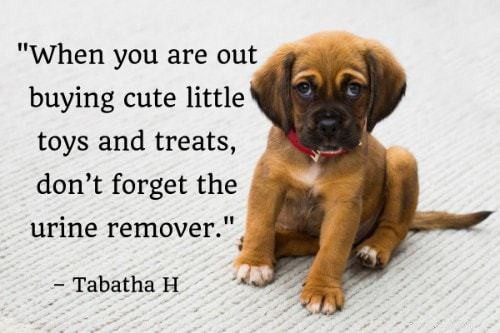
13. Prévoyez lesdits accidents. "Lorsque vous achetez de jolis petits jouets et friandises, n'oubliez pas le dissolvant d'urine. Ne pensez pas que vous pouvez utiliser n'importe quel vieux nettoyant. Même si vous ne pouvez plus le sentir, votre chien le peut. Vous avez besoin d'un nettoyant spécifique pour nettoyer ses dégâts, cela éliminera également l'odeur pour lui. Un chien continuera à aller là où il peut le sentir. Avez-vous déjà vu un chien renifler le sol en cherchant un endroit où aller ? C'est pourquoi, en général, il cherche un endroit où il est déjà allé ou un endroit qu'un autre chien a. – Tabatha H, 5 conseils pour cambrioler votre chiot lorsque vous travaillez à plein temps, Dogvilles ; Gazouillement : @DogVills
14. Gardez un œil sur lui. «Surveillez attentivement votre chiot lorsque vous êtes à la maison avec lui pour tout signe indiquant qu'il doit sortir; cela pourrait inclure faire les cent pas, gratter à la porte ou pleurnicher. Emmenez-le immédiatement à l'extérieur et félicitez-le lorsqu'il utilise le bon endroit de la salle de bain. – Lori Lapierre, Comment domestiquer un chiot si vous travaillez toute la journée , Le nid; Twitter : @TheNest
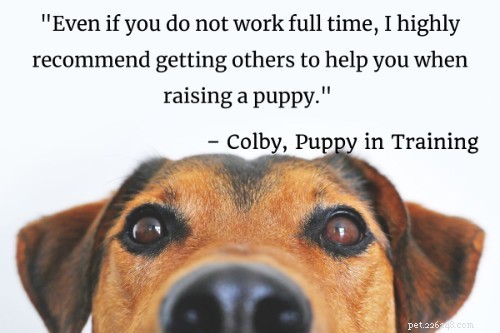
15. Si vous travaillez, cela peut prendre un village pour élever un chiot. « Je vous recommande de faire appel à une ou plusieurs [...] personnes pour vous aider, mais votre chiot doit aussi s'habituer à passer du temps seul pendant la journée. Je me ferais un objectif d'essayer de ne pas mettre votre chiot en cage plus de 1 à 2 heures deux fois par jour. Même si vous ne travaillez pas à temps plein, je vous recommande fortement de demander à d'autres de vous aider à élever un chiot. J'entends souvent dans la communauté des chiens-guides et des chiens d'assistance :« Il faut tout un village pour élever un chiot. » Soit dit en passant, vous n'aurez pas besoin de l'aide de vos amis et de votre famille pour toujours. Bien que je sois sûr que votre chiot appréciera toujours la compagnie des gens plutôt que d'être laissé seul, la plupart des gens ne peuvent pas passer du temps avec leurs chiots 24 × 7. " – Colby, Que faites-vous de votre chiot lorsque vous travaillez à plein temps ?, Chiot en formation ; Twitter : @PuppyInTraining
16. Célébrez ses victoires. "Avec le défi supplémentaire de faire sortir votre chiot de votre appartement avant qu'il ne devienne pot, il est d'autant plus important de célébrer chaque victoire. Les chiens réagissent incroyablement bien au renforcement positif. Le simple son de votre voix joyeuse peut faire plus pour aider à l'apprentissage de la propreté que les friandises ne pourraient jamais le faire. Ne punissez jamais ou ne criez jamais après votre chiot pour avoir eu un accident à l'intérieur. Les punitions ne feront que dresser votre chiot, vous ne pouvez pas lui faire confiance et peuvent entraîner des problèmes de comportement liés à l'anxiété. – Dina Fantegrossi , Le jeu de la propreté :comment éduquer votre chiot en appartement, Résidentiel AMLI ; Gazouillement : @AMLIapts
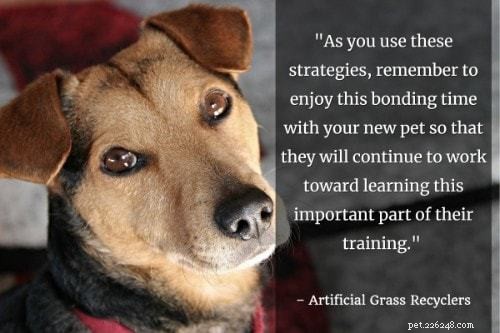
17. N'oubliez pas que c'est aussi un moment de complicité. Vous devez le former, oui. Mais instaurer la confiance ne servira qu'à faciliter sa formation, alors ne la sautez pas. "Lorsque vous utilisez ces stratégies, n'oubliez pas de profiter de ce temps de liaison avec votre nouvel animal de compagnie afin qu'il continue à travailler pour apprendre cette partie importante de son dressage." – 7 conseils pour l'apprentissage de la propreté d'un chiot dans un appartement , recycleurs de gazon artificiel ; Twitter : @agrecyclers
18. Prendre des notes. « Pendant plusieurs semaines, j'ai tout écrit. Bientôt, j'ai pu voir des modèles et cela m'a permis de devancer Emily. Par exemple, tous les soirs vers 2 heures du matin, elle se mettait à pleurer et à se gratter. Au moment où elle a commencé à s'agiter, il était trop tard. Alors, j'ai mis une alarme à 1h45 et je l'ai fait sortir dans la rue bien à l'avance. Tout écrire, y compris quand elle a eu une giclée d'excitation après que les gens l'ont criée dessus (ce qui était souvent le cas), a fait toute la différence. – Mara Bovsum, Gros chien, grande ville :comment réussir la formation à la maison , American Kennel Club; Twitter :@akcdoglovers
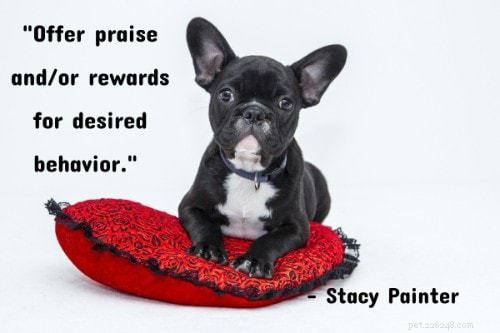
19. Récompensez-le comme il veut être récompensé. « Offrez des éloges et/ou des récompenses pour le comportement souhaité. Que votre chien réponde mieux aux éloges verbaux, à un jouet préféré ou à une friandise spéciale, assurez-vous de lui prodiguer un stimulus positif chaque fois qu'il se rend avec succès au bon endroit. – Stacy Painter, Apprentissage de la propreté de votre chiot lorsque vous vivez en appartement , vétérinaire préventif ; Twitter : @PreventiveVet
20. Vers la fin de l'entraînement, introduisez la cloche. «Une façon amusante et amusante de dresser votre chien à la maison est de l'entraîner à vous communiquer quand il a besoin d'aller au pot en lui apprenant à sonner une cloche de train de pot. Ceci est mieux enseigné après que votre chien semble préférer sortir pour faire ses besoins et que vous voudriez lui donner un bon moyen de vous le communiquer. La sonnette pour chien fonctionne particulièrement bien pour les chiens qui n'ont que peu d'accidents ou qui ont des accidents près de la porte. Apprendre à votre chien à sonner une cloche l'empêche d'avoir recours à des comportements "non civilisés" comme gratter à la porte ou aboyer pour vous dire de le laisser sortir. – Jess Rollins, Dog Bell Training :Entraînez votre chien à sonner une cloche pour aller au petit pot, Expertise pour animaux de compagnie ; Gazouillement : @PetExpertise
Consultez ces ressources et produits pour l'apprentissage de la propreté de votre chiot :
- Comment domestiquer votre chien en 7 jours (révisé)
- L'éducation à la propreté de votre chien
- Guide ultime pour dresser votre chiot à la maison
- Caldwell's Pet Supply Co. Sonnettes d'entraînement à la propreté pour chiens Potty Bells
- Éducation des chiots :comment domestiquer votre chiot en seulement 7 jours !
- PUPPYPRO Plateau d'apprentissage de la propreté pour chiots
- Guide complet de l'apprentissage de la propreté pour les chiots
- Sonnettes pour chien Zacro pour dressage de chiens et 1 clicker de dressage
- Apprendre à écouter
Cage dressant un chiot

21. Comprendre le but d'une cage pour chien. "Les chiens sont naturellement des animaux de tanière. Dans la nature, la tanière d'un chien est sa maison, un espace sûr où il peut dormir, se retirer et élever des chiots sans crainte de danger, sans menace extérieure. Pour un chien domestique, une cage répond à ce besoin naturel de refuge. Si elle est introduite et utilisée correctement, la cage sera l'endroit où votre chien choisira volontairement de dormir, de se cacher en cas d'orage et, très probablement, de s'allonger sans autre raison que son propre espace. – Sara Logan Wilson, L'éducation de votre chiot en cage :la clé d'une maison sans pipi, Journal canin ; Twitter : @CanineJournal
22. N'abusez pas de la caisse. "Une cage n'est pas une solution magique au comportement canin courant. S'il n'est pas utilisé correctement, un chien peut se sentir piégé et frustré. N'utilisez jamais la caisse comme punition. Votre chien en viendra à le craindre et refusera d'entrer. – Formation en caisse 101 , Humane Society des États-Unis d'Amérique; Twitter : @HumaneSociety

23. Il y a de grands avantages à la formation en caisse. « Une caisse fonctionne bien comme un lit. Parce qu'elle est fermée, la caisse pour chiots sert également de refuge sûr pour s'éloigner des autres animaux de compagnie ou des enfants qui harcèlent. Vous ne voulez pas un endroit privé où vous ne serez pas dérangé ? Les chiots ne sont pas différents. Une caisse peut également être un endroit sûr pour confiner ce chiot exubérant. Cela lui évite des ennuis lorsque vous ne pouvez pas le regarder. Par ailleurs, la plupart des chiens doivent être confinés de temps en temps, lorsqu'ils se déplacent en voiture ou qu'ils séjournent chez le vétérinaire, par exemple. Donc, déjà connaître et accepter une caisse devrait faire partie de la formation de votre chiot. C'est l'un des meilleurs outils disponibles pour aider à l'apprentissage de la propreté de votre chiot." – Amy Shojai, Puppy Crate Training, Les animaux de compagnie de l'épinette ; Twitter : @amyshojai
24. Comprendre le processus de formation en caisse. "La formation en cage peut prendre des jours ou des semaines, selon l'âge, le tempérament et les expériences passées de votre chien. Il est important de garder deux choses à l'esprit lors de la formation en caisse. La caisse doit toujours être associée à quelque chose d'agréable, et l'entraînement doit se dérouler par petites étapes, n'allez pas trop vite. – Comment dresser votre chien en caisse , pattes; Gazouillement : @PAWStweets
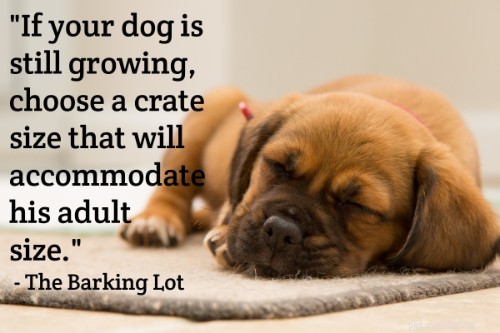
25. Choisissez la bonne caisse. « La cage de votre chien doit être juste assez grande pour qu'il puisse se lever et se retourner. Si votre chien grandit encore, choisissez une taille de cage qui s'adaptera à sa taille adulte. Bloquez l'espace excédentaire de la caisse afin que votre chien ne puisse pas éliminer à une extrémité et se retirer à l'autre. Votre refuge pour animaux local peut louer des caisses. En louant, vous pouvez échanger jusqu'à la taille appropriée pour votre chiot jusqu'à ce qu'il atteigne sa taille adulte, lorsque vous pouvez investir dans une caisse permanente. – Crates 101 : Un guide de formation aux caisses , Le Lot Aboiement; Twitter : @TBLTweets
Consultez nos listes des meilleures cages pour petits chiens et des meilleures cages pour grands chiens pour trouver la cage parfaite pour votre chiot.
26. Faites une bonne introduction à la caisse. « Placez la caisse dans un endroit familier de votre maison et laissez la porte de la caisse ouverte. Laissez des friandises ou des jouets dans et autour de la cage, ce qui encouragera votre chien à explorer l'intérieur de la cage. Cette étape peut durer quelques jours, en fonction du confort de votre chien lors de sa première rencontre avec la caisse. N'oubliez pas que donner à un chiot suffisamment de temps pour s'adapter à chaque étape de la formation en cage aidera l'ensemble du processus de formation à se dérouler sans heurts. , traitement quotidien ; Twitter : @RoverDotCom
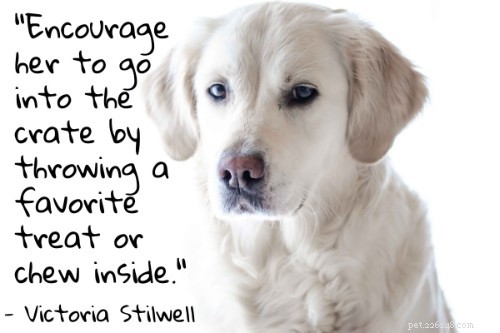
27. Ne forcez pas votre chiot. "Encouragez-la à entrer dans la caisse en jetant une friandise préférée ou en mâchant à l'intérieur. Si votre chiot décide de s'installer, permettez-lui de le faire sans fermer la porte afin qu'il puisse décider lui-même de rester ou de partir. Une fois qu'elle est à l'aise d'entrer dans la caisse, commencez à fermer la porte pendant quelques secondes à la fois, en augmentant progressivement la durée tant qu'elle est détendue. – Victoria Stilwell, Formation en caisse , Positivement; Gazouillement : @VictoriaS
28. Commencez par des temps courts avec la porte fermée. « Vous n'avez même pas essayé de fermer la porte avec lui à l'intérieur. À droite? Ceci est important car vous voulez qu'il aime absolument entrer dans la caisse et qu'il n'ait pas peur ou ne s'inquiète pas pour la porte. Une fois qu'il l'a compris, vous devriez être prêt à commencer à fermer la porte. Commencez la séance comme vous l'avez laissée, mais cette fois, fermez la porte de la caisse pendant quelques secondes pendant qu'il mange encore les dernières friandises que vous avez jetées. Ouvrez la porte de la caisse et laissez-le sortir avant qu'il ait fini de manger. Répétez environ trois ou quatre fois. L'étape suivante consiste à commencer à augmenter progressivement le temps de fermeture de la porte, avec votre chiot à l'intérieur bien sûr. On parle de secondes et non de minutes donc c'est vraiment lent. Déposez quelques friandises dans la caisse pendant que la porte est fermée pour qu'il reste heureux. Ne vous éloignez pas et ne le laissez pas à ce stade. L'ajout d'un jouet préféré ou d'un Kong en peluche l'occupera. Cela aidera également à accélérer le processus de dressage de votre chiot en cage si vous donnez des repas dans la cage. – Sharon, Entraînement à la caisse d'un chiot , Connaissance des soins pour chiens ; Twitter : @Dogcareknow
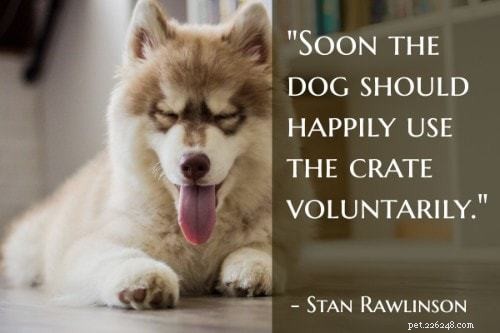
29. Introduisez progressivement des heures de coucher en caisse. « Bientôt, le chien devrait volontiers utiliser la caisse volontairement. Lorsque vous atteignez ce stade, (PAS AVANT) attendez qu'il s'endorme, puis fermez la porte. Restez dans la pièce et laissez-le sortir alors qu'il commence à se réveiller. Lorsque votre chien est habitué à cette routine, laissez-le pendant une minute après son réveil (avec vous toujours dans la pièce). Augmentez progressivement (sur environ une semaine) le temps pendant lequel vous pouvez le faire. – Stan Rawlinson, Crate Training Puppies The Easy Way , ChienÉcouteur
30. Vous devrez toujours vous lever au milieu de la nuit. "Laissez un chiot sortir de sa cage toutes les deux heures lorsque vous commencez l'entraînement, en particulier entre 8 semaines et 12 semaines. Le site Web de la Humane Society des États-Unis indique que les chiots de moins de 6 mois peuvent être dans une caisse pendant trois à quatre heures à la fois, au maximum. Cela ne signifie pas que vous devrez vous lever au milieu de la nuit tous les soirs pendant six mois ou plus; mais vous ne pourrez pas y aller toute la nuit pendant un certain temps. De lui-même, le chien dormira toute la nuit quand sa vessie le lui permettra. S'il dort profondément, il n'est pas désespéré de faire pipi. Celui qu'il réveillera, cependant, il le sera. – Melodie Anne, Mon chiot peut-il dormir dans une autre pièce dans sa cage la nuit ? , Le nid; Twitter : @TheNest
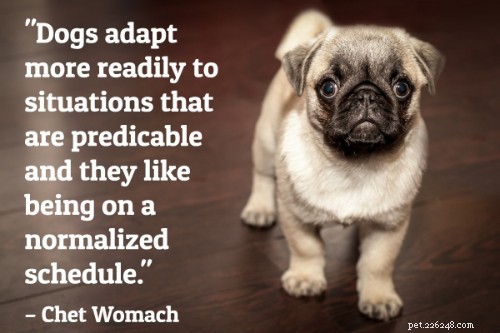
31. Coupez l'eau avant de vous coucher. "Pour faciliter ce processus pour vous deux, je vous suggère de prendre de l'eau 2 heures avant le coucher et de sortir avec votre chiot la dernière chose avant d'aller vous coucher le soir. Restez sur un horaire! Les chiens s'adaptent plus facilement aux situations prévisibles et ils aiment suivre un horaire normalisé. – Chet Womach , Chiots dressés en caisse , Le secret de dressage de chiens ; Gazouillement : @DogTrainer411
32. Respectez les directives. «Une bonne règle de base est qu'un chien peut être mis en caisse pendant la nuit et jusqu'à une demi-journée, à condition que ses besoins sociaux et physiques soient satisfaits lorsqu'il n'est pas dans la caisse. Les jeunes chiots ont besoin de siestes plus fréquentes et d'occasions beaucoup plus fréquentes de « faire leurs besoins » que les adultes. Une bonne estimation du temps qu'un chiot peut attendre avant d'avoir besoin de se soulager est d'autant d'heures qu'il a de mois, plus un. Ainsi, un chiot de trois mois peut se débrouiller pendant environ quatre heures. Pendant la nuit, il peut généralement tenir un peu plus longtemps, généralement environ 1,5 fois le maximum de la journée, soit environ six heures pour un enfant de trois mois. Mais n'oubliez pas que les chiots doivent être complètement socialisés avant l'âge de cinq mois, donc ces heures éveillées et hors de la caisse sont très précieuses pour la socialisation ! – Jennifer Messer, La vérité d'un entraîneur sur les caisses , Magazine de chien moderne ; Twitter : @ModernDogMag

33. Trop de temps dans une cage peut être nocif pour votre chiot. "[Certains] pensent qu'un confinement prolongé peut être dommageable - et ils disent que certaines personnes enferment des chiens de compagnie dans de minuscules caisses jusqu'à 18 à 22 heures au total par jour. Les chiens trop en cage, disent-ils, peuvent souffrir de complications de la «rage en cage», de l'anxiété, de la peur et de la dépression. – Sofija Stefanovic, Dans la niche :à quel moment la mise en caisse de votre chien devient-elle un abus ? , Le gardien; Twitter : @gardien
34. Ne l'exposez pas à des sentiments de trahison. "Variez toujours la durée que votre chien passera dans sa cage, surtout pendant l'entraînement. Cela empêchera votre chien de « s'attendre » à sortir à un moment donné et réduira les problèmes tels que les gémissements ou les grattages à la porte de la cage. » – Crate Training Your Dog , RSPCA Victoria ; Twitter : @RSPCAVIC
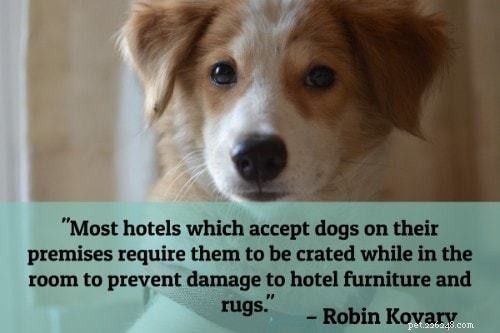
35. Les caisses servent à plusieurs fins. "Une caisse de chenil sert également de cabine de voyage pour votre chien lors de vos déplacements en voiture ou en avion. De plus, la plupart des hôtels qui acceptent les chiens dans leurs locaux exigent qu'ils soient mis en caisse dans la chambre pour éviter d'endommager les meubles et les tapis de l'hôtel. – Robin Kovary, Formation en caisse , INCH :Chaîne Internet
36. Mettez votre chiot à l'aise dans sa cage. "Vous devrez également équiper leur caisse avec de la literie. Si le chien ne mâche pas de tissu ou de litière de terre, vous pouvez utiliser une serviette ou une couverture légère à l'intérieur de la cage. Le journal n'est pas une bonne idée, car il peut envoyer le message de "pot ici", surtout si le chien a déjà été formé pour aller sur papier. Quelques chiens urineront dans une caisse si la litière est fournie. Si votre chien fait cela, retirez la litière jusqu'à ce que le chiot commence à comprendre que la litière est pour dormir, pas pour un coussin de pot ! – Le dressage en cage et le cambriolage en toute simplicité :dresser un chiot à la maison , temps de chien ; Twitter : @dogtimedotcom
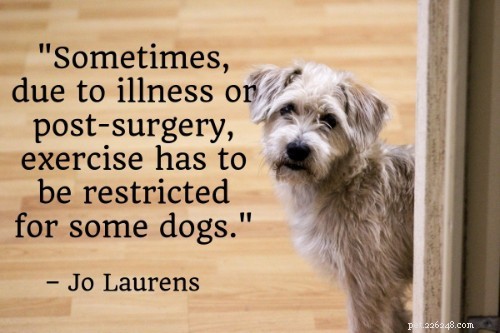
37. Parfois, les caisses sont juste nécessaires. Et votre chiot n'aura-t-il pas une longueur d'avance si cela se produit? "Si votre chiot doit aller chez le vétérinaire pour une intervention ou une intervention chirurgicale, il sera mis en caisse dans une cage pour chien avant et après. Si elle a l'habitude d'être ainsi confinée, elle sera beaucoup moins stressée avant et après son opération. Parfois, en raison d'une maladie ou d'une opération post-opératoire, l'exercice doit être limité pour certains chiens. – Jo Laurens, Crate Training A Puppy - Le guide expert ultime, Le site Happy Puppy
38. La mise en caisse peut aider pendant les périodes chaotiques. « La mise en caisse peut même être une bonne idée pour les chiens adultes au moment des repas ou lorsque vous avez des invités; c'est à ce moment-là que même les chiens les plus charmants peuvent devenir une nuisance. – Attentes en matière de cage :dresser votre chien en cage , Petsmart; Gazouillement : @PetSmart
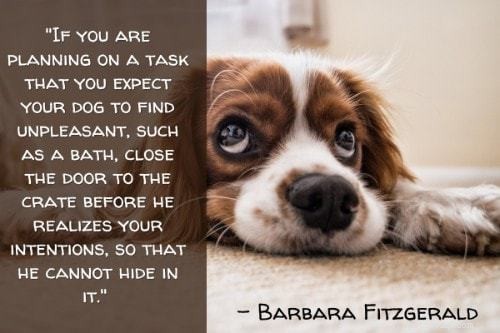
39. Ne traînez jamais votre chien hors de sa cage. "Si vous prévoyez une tâche que vous pensez que votre chien trouvera désagréable, comme un bain, fermez la porte de la cage avant qu'il ne réalise vos intentions, afin qu'il ne puisse pas s'y cacher. Vous voulez éviter de transformer son refuge en champ de bataille avec vous essayant de le traîner hors de sa tanière. – Barbara Fitzgerald, 5 conseils sur l'entraînement à la cage :la bonne façon de mettre un chiot dans une cage , animal de compagnie utile ; Twitter : @PetHelpful
40. N'ignorez jamais une peur de ou autour de la caisse. "[Essayez] de trouver ce qui effraie votre chiot et de l'éliminer. Parfois, c'est la caisse elle-même; essayez de changer de caisse pour soulager son stress. Un autre problème possible pourrait être que vous essayez de la sortir de sa tanière alors qu'elle ne veut pas la quitter. N'essayez jamais de forcer votre chiot à sortir. Apprenez-lui plutôt à quitter la caisse sur votre ordre verbal. , Animaux
Consultez ces ressources et produits pour dresser votre chiot en cage :
- Entraînement à la cage pour chiots :Entraînement pour chiots Iams®
- Formation à la caisse
- Comment dresser un chiot en cage
- Guide de formation sur les caisses positives de la Karen Pryor Academy
- Crate Training Cesar Milan Dog Whisper
- Comment former votre chiot !
- Formation en cage pour votre chien ou chiot
- Livre électronique de formation à la caisse
- Formation en cage :un manuel de A à Z sur la façon de former un chiot en cage, les chiens de formation en cage, le calendrier de formation en cage et bien plus encore
- Comment dresser votre chiot en cage
- Dog Training :A Step-by-Step Guide to Leash Training, Crate Training, Potty Training, Obedience and Behaviour Training (Livres de dressage de chiens) (Volume 1)
Formation d'obéissance pour chiots
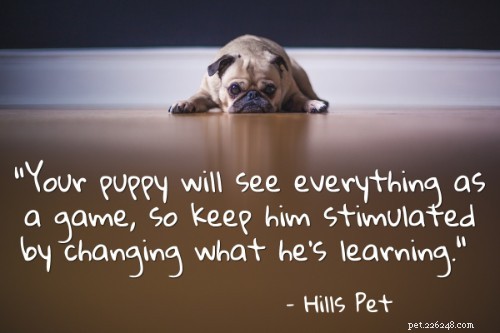
41. Soyez bref. “Your puppy will see everything as a game, so keep him stimulated by changing what he’s learning. Do each command for about five minutes and come back to it whenever you can.” – Teaching Your Puppy:Obedience Training Basics , Hills Pet; Twitter: @HillsPet
42. Start early and create a bond. “To establish a positive rapport with your puppy and prevent many future problems, start training a few days after your puppy settles in. A relationship based on friendship and trust will ensure that he tries hard to win you praise and approval.” – Kathy Santo, Puppy training basics, IAMS; Twitter: @IAMS
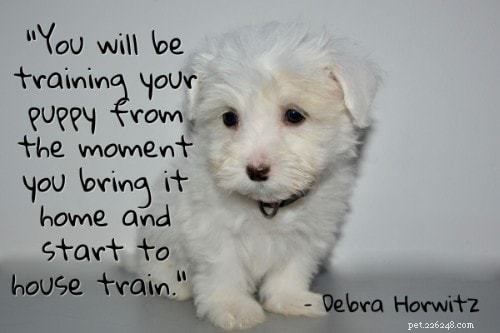
43. No, really early. “You will be training your puppy from the moment you bring it home and start to house train. Puppies start learning from birth and good breeders begin handling and socialization right away. Some training can begin as soon as the puppy can open its eyes and walk. Young puppies have short attention spans but you can expect them to begin to learn simple obedience commands such as ‘sit,’ ‘down,’ and ‘stay,’ as young as 7 to 8 weeks of age.” – Debra Horwitz, Puppy Behavior and Training – Training Basics , VCA Hospitals; Twitter: @VCAPetHealth
44. Training them will mitigate future behavior problems. “Dogs have their own set of behavioral problems. Lack of discipline may badly affect your dog’s behavior and turn your beloved pet into a disobedient, aggressive or unruly dog. As a dog owner you should be aware of these problems and train your dog accordingly.” – How To Train Your Dog , Train Pet Dog; Twitter: @trainpetdog

45. His name matters. “Of course you’ll want to pick a name for your new puppy or dog that you love, but for the purposes of training it also helps to consider a short name ending with a strong consonant. This allows you to say his name so that he can always hear it clearly. A strong ending (i.e., Jasper, Jack, Ginger) perks up puppy ears—especially when you place a strong emphasize at the end.” – 10 Best Training Tips , Pedigree; Twitter: @PedigreeUS
46. Proper training will make your dog a better community participant. “Dog Training for Obedience lays down a set of rules or boundaries which educates your dog to become a responsible member of society. Including how to relate to other dogs, animals and people, basic manners and how to behave in any situation.” – Dog Training For Obedience – The Key To Raising A Well Behaved Dog , Dog Training Central; Twitter: @ThePaw_com
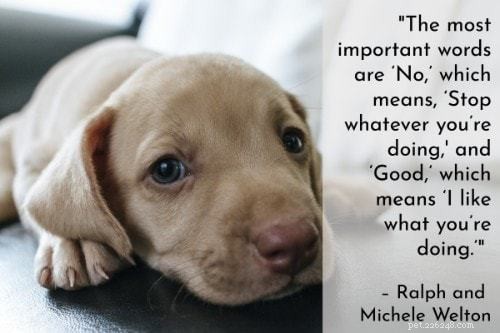
47. Work on his vocabulary. “The most important words are ‘No,’ which means, ‘Stop whatever you’re doing,’ and ‘Good,’ which means ‘I like what you’re doing.’ These praise and correction words should be started at 2-3 months of age. You must teach these words properly, with the right tone of voice and the right body language, or they won’t be of any help in teaching other words. If your puppy is older than 2-3 months and hasn’t learned ‘No’ and ‘Good’ flawlessly, you must start with those words before you can expect success with other word training.” – Ralph and Michele Welton, Puppy Training Schedule:What To Teach Puppies, and When, Your Purebred Puppy; Twitter: @yourpurebredpup
Check out our list of the Best Dog Training Collars to find the perfect training collar for your puppy.
48. Give plenty of affection. “Most people don’t have a problem being very clear about when they are unhappy with their dogs, but, they often ignore the good stuff. Big mistake! Make sure you give your dog lots of attention when he’s doing the right thing. Let him know when he’s been a good boy. That’s the time to be extra generous with your attention and praise. It’s even okay to be a little over the top.” – Traci Theis and Kellyann Conway, Top Ten Dog Training Tips, Pet Finder; Twitter: @petfinder
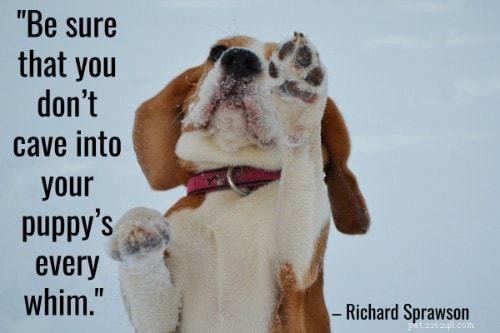
49. But don’t overwhelm the puppy. “Your new puppy has just been taken away from her mom and littermates. She is vulnerable and impressionable. What she needs now is security and routine. Play with her quietly and gently. Don’t flood her with attention and activity. If she looks like she wants to sleep, leave her alone. Puppies need lots of sleep.” – Training Puppy the First Week, Perfect Paws
50. Know your dog’s personality. “Intuitively, we all know that our dogs are like no others. They react hilariously to the most benign and everyday of sounds, or they sleep on their backs trying to copy the humans they watch daily. But, it’s not uncommon to totally forget how unique our dogs are when it comes time to do some training. Fittingly, despite some opinions to the contrary, there is no one holy grail method of training. Get to know your dog’s personality and you’ll have the keys to effective training sessions.” – Rosalee Kaschel, How Your Dog’s Personality Affects Training , PetSafe; Twitter: @PetSafe
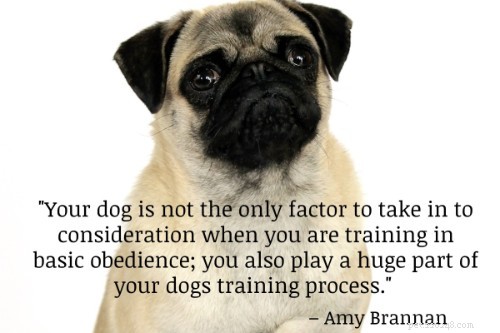
51. Factor in you , too. “Your dog is not the only factor to take in to consideration when you are training in basic obedience; you also play a huge part of your dogs training process. If you are considerably impatient or easily frustrated then you are going to want to approach teaching your dog obedience in short lessons that focus on one command at a time. You can also benefit from enrolling in a small obedience class that will allow you a reprieve if you are feeling overwhelmed.” – Amy Brannan, Dog Obedience Tips:Patience Is Key , Canine Journal; Twitter: @CanineJournal
52. Train yourself. “Most owners mistakenly believed they need to have their dogs trained when in fact the owners need the education more than the dog do. The most important component in any successful relationship between dog and owner is that the owner understands the dog and that the dog understands the owner.” – Matthew Kinneman, Puppy Obedience Training Tips The Top Ten Mistakes Owners Make , Vitamins For Pitbulls; Twitter: @bullymax
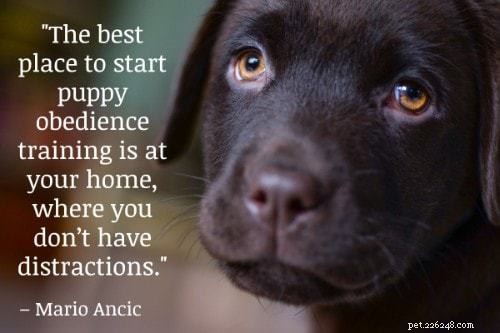
53. Start at home. “The best place to start puppy obedience training is at your home, where you don’t have distractions and where your puppy is familiar, so we can avoid the environmental stress factor that happens when a dog is in a new and unfamiliar place. Remember your puppy is in the learning phase, later on during our next steps we will add different stress factors and distractions.” – Mario Ancic, Puppy Obedience Training…Where It All Begins , Training Your Dog and You
54. Remember your dog wants to please you. “Understanding more about how a dog thinks and what is ‘normal’ for your dog will help you. It is important to remember that, for the most part, our dogs are keen to please – so if they are not doing as you ask, it may be because you are not being clear about what you want or are not using rewards, commands and body language in a way your dog understands.” – Dog Obedience Training, Purina; Twitter: @Purina
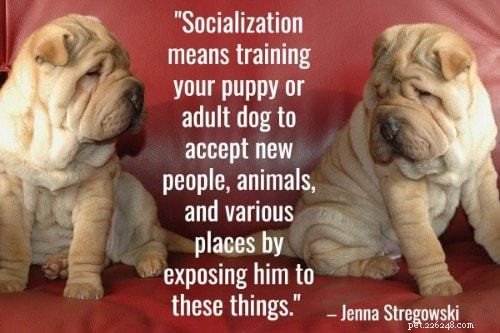
55. Socialize your puppy early. “Socialization means training your puppy or adult dog to accept new people, animals, and various places by exposing him to these things. Socialized dogs are less likely to develop behavior problems and are generally more welcomed by others. Socialization can also help prevent the development of fears and phobias. The bottom line is that socializing your dog or puppy will make him a happier, more well-behaved dog.” – Jenna Stregowski, 10 Steps To Train Your Dog , The Spruce Pets; Twitter: @JennaDogs
56. Start with basic commands. “To start, force yourself to slow down and focus on one command at a time with the plan to work through all of the basics, which include:sit, stay, heel, down, kennel and place.” – Tom Dokken, 4 Tips for Dog Obedience Training , Gun Dog; Twitter: @GunDogMag

57. Stay firm. “This is where you learn how to show your dog that you are the one in charge, that you are the alpha leader and that you are the person they need to listen to you. This will make training your puppy a lot easier. As your puppy grows, so will his need to assert himself. Be sure that you don’t cave into your puppy’s every whim.” – Richard Sprawson, Beagle Puppy Obedience Training Tips And Methods , Beagles In My Kitchen; Twitter: @rgs112
58. There are no shortcuts. “Be careful of advertisements for 10 minute puppy obedience training programs and the like. There are no miracle cures in puppy training.” – Puppy Obedience Training – How to Care for a Puppy , Shiba Shake
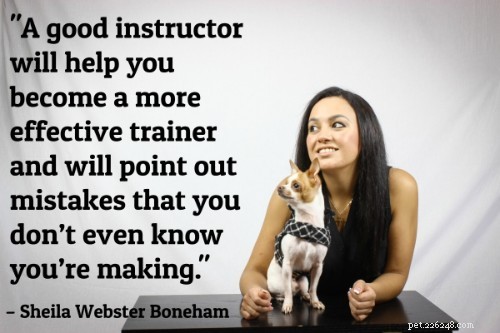
59.Consider enrolling in a good obedience class. “A class environment provides for some of the socialization your dog needs and teaches him to respond to you even with exciting distractions all around. A good instructor will help you become a more effective trainer and will point out mistakes that you don’t even know you’re making.” – Sheila Webster Boneham, How to Find a Good Dog Trainer and Obedience Class, Nylabone; Twitter: @nylabone
60. Mentally prepare for the bad days. “Not every training day is going to be perfect, but don’t get frustrated and don’t take it out on your dog. Adjust your own behavior and attitude to encourage your dog’s ability and confidence to learn. If you have a calm mood, generally your dog will, too. If the dog becomes afraid of your bad mood, he will not learn anything new. He’ll only learn to be wary and not trust you.” – How to Train a Dog , WikiHow; Twitter: @wikiHow
Check Out These Resources and Products for Puppy Obedience Training:
- Obedience Training for Dogs
- Dog Obedience:Getting Your Pooch Off the Couch and Other Dog Training Tips
- How to teach ANY dog to Come when called!
- Obedience Schools Near Me
- Introduction to Dog Training
- How To Teach Any Dog PERFECT Obedience! (Sit,Down,Stand)
- How to Stop the 10 Most Common Dog Obedience Problems
- The Power of Positive Reinforcement:The Key to Unleashing Your Dog’s True Potential
- Dog Training Academy:Obedience Training For Dogs
- What’s Good About Dog Training EBooks?
- Puppy training:Train your puppy in obedience, potty training and leash training in record time
- Zak George’s Dog Training Revolution:The Complete Guide to Raising the Perfect Pet with Love
- BKLN Manners:Positive Training Solutions for Your Unruly Urban Dog
- Pet Botanics Training Reward
- Dog Treat Bag –Training Pouch for Small and Large Dogs with Clicker and Collapsible Food Bowl
Leash Training a Puppy

61. Make a connection first. “If we had just met and you wanted to take a walk with me, how comfortable would we be together at first? We most likely would be a bit guarded with one another until we knew each other better. The same is true for a relationship between a dog and their human. […] Get to know your dog and let him get to know you, too. Work on reinforcing eye contact every time you say his name – which is most likely a brand new name for your dog. Say the name or make a noise to get his attention, and when he looks at you, say YES! and toss him a good treat. Eye contact and acknowledgement that you are seeking his attention is the first step of all training, so you really can’t do too much of this.” – Annie Phenix, How to Train Your Dog to Walk Nicely On Leash , Lucky Puppy Magazine; Twitter: @myluckypuppy
62. Leash training is a critical part of maintaining your dog’s safety and promoting your bond. “Learning how to walk properly on leash makes it safer for your pet and more enjoyable for both of you (ever seen someone fighting to keep their leashed dog under control, while it drags them relentlessly down the street? Doesn’t look like much fun…). Remember that cute little balls of fluff are still very young and their attention span can be short, so patience is a must when it comes to leash training your puppy. Positive reinforcement is important – reward your puppy for every little thing he does right during your puppy training sessions.” – Puppy Leash Training Tips , Scampering Paws
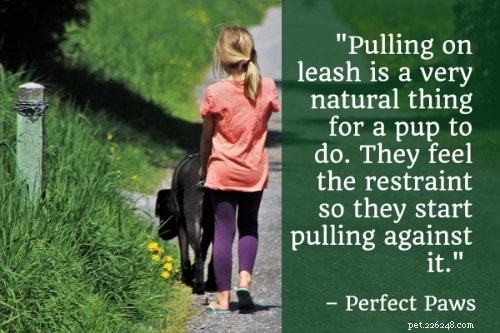
63. Give it a few trial runs before going outside. “Pulling on leash is a very natural thing for a pup to do. They feel the restraint so they start pulling against it. Let’s start the puppy leash training indoors with no distractions. Accustom the puppy to walking on a loose leash at your side. It’s important that you teach your puppy to walk on one side only. The standard is your left hand side. It really doesn’t matter which side, but choose only one and stick with it – this way your puppy won’t be tripping you up by changing sides.” – Puppy Pulling On Leash, Perfect Paws
64. Make sure your dog associates fun things with the leash. “Fill an interactive toy with food and freeze overnight. Now, attach a leash to your dog’s harness and let your dog drag it around the house for a bit. To make this experience positive and to keep a puppy from chewing on the leash, give your dog a frozen food stuffed toy to enjoy while wearing and dragging his leash around the house. Once your dog has finished his food stuffed toy, remove the leash and put it away. Practice this game several times a day. You can certainly fill interactive toys with your dog’s daily meals for more leashes-make-fun-things-happen moments. Remember, you’re not holding the other end of the leash. Your dog is learning that attached leashes are harmless and make good things appear like food stuffed toys. Practice for 3-4 days before moving onto the next step.” – Fanna Easter, What to Do When Your Puppy Won’t Walk on Leash , Dog Training Nation; Twitter: @DogTrainNation
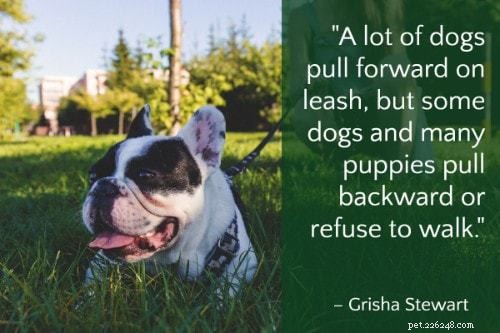
65. Your dog may be extra stubborn. “A lot of dogs pull forward on leash, but some dogs and many puppies pull backward or refuse to walk. This happens to French Bulldogs and English Bulldogs all the time! Pulling harder or luring with a treat only makes the problem worse.” – Grisha Stewart, What to Do When a Dog Refuses to Walk , Ahimsa Dog Training; Twitter: @grishastewart
66. For dogs who pull back or away, stay away from retractable leashes. “When Sunshine [the dog] pulls on the leash it doesn’t make the walk enjoyable for her guardians or the dog. The guardians had used a retractable leash, which allows Sunshine a lot of freedom. But if you have a dog that is not well behaved on the leash this additional amount of freedom can contribute to the problem. If your child is not the best driver, you wouldn’t to give it more unsupervised driving privileges; you would go back to basics and have the child practice more in a structured environment to build up the skills necessary to be a good driver. This same principal applies to your dog walking on the leash.” – Sam Kanouse, Great Leash Training Tips to Stop a Golden Retriever Puppy from Pulling on the Leash , Dog Gone Problems; Twitter: @DogGoneProblems
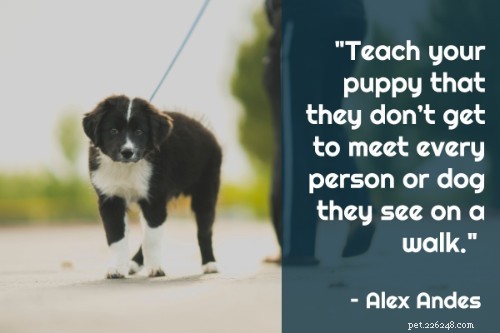
67. You must teach your puppy he can’t meet everyone. “Teach your puppy that they don’t get to meet every person or dog they see on a walk. I cannot emphasize the importance of this enough. Leash reactivity (barking, lunging, growling on leash) is the most common behavior problem I work with. In the majority of cases, it results from the dog’s frustration with being unable to get to the other dog.If we teach puppies from a very young age that walks are structured, require focus on the owner, and aren’t a social hour, it can help your puppy grow up to have reasonable expectations when seeing another dog on leash. Even with ‘social butterfly’ puppies, we don’t greet every dog we pass. When we do greet a dog or person, I teach them to sit and make eye contact with the person walking them before they are released for a brief greeting. This type of structure is critically important in order to have a dog that’s friendly and social – but also has self-control.” – Alex Andes, 5 Little-Known Puppy Training Tips You’ll Be Glad You Found , Peach on a Leash
68. Remain Calm. “Try to start all walks in a relaxed state. Often dogs get very excited to see a leash. They know it possibly means they’ll be allowed to go out and explore. Introduce the leash when your dog is calm and keep a relaxed attitude yourself throughout the entirety of your walk” – Napa ‘ze Dog, Tips for Leash Training a Puppy , Napa’s Daily Growl; Twitter: @NapatheDog

69. Use the proper gear. “Practice with a 6-foot regular leash that is long enough to create some slack. Always use a flat buckle collar or harness. No choke chains, prong collars, and definitely no shock collars.” – Sharon Dianora, Leash Training a Puppy To Walk Calmly , Dog Care Knowledge; Twitter: @Dogcareknow
70. Let him hit the jackpot! “Remain calm at all times, and utilize jackpots (more treats or better treats) when your dog accomplishes something that was difficult for him; i.e., not pulling you toward the neighbor dog! Jackpot for any eye contact or focus on you! Keep leash training sessions short and FUN! You can train several times a day, but you don’t want to push you or your dog past the point of fun! Puppies, especially, have short little attention spans, and if you insist on puppy training past the point of fun – usually around five minutes – your pup may start to dislike, and dread training!” – Leash Training Tips To Stop The Pulling And Enjoy Your Walks Again , The Dog Training Secret; Twitter: @DogTrainer411
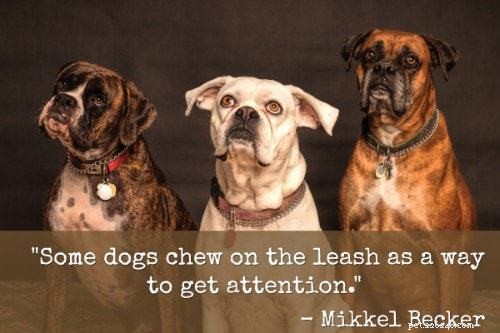
71. If he’s chewing on his leash, he may be over stimulated or desperate for attention. “Some dogs chew on the leash as a way to get attention. When your dog is walking calmly on a loose leash, no one pays attention to him, but when he acts out, the focus shifts directly to him. For many dogs, negative attention is better than no attention at all. Other dogs are over-aroused, and the easiest way to release tension is to bite on the leash. In the shelter situation, dogs frequently grab and chew on the leash, often when first taken out of the kennel and led with other dogs. The more intense the situation and the more wound up a dog is, the more likely that leash biting will occur.” – Mikkel Becker, Put a Stop to Leash Chewing and Tugging, Vet Street; Twitter: @Vetstreet
72. Not all dogs get the same gear. “A front-attachment harness is a safe and easy to use no-pull device that is great for all dogs. Choose a head collar for dogs with aggressive tendencies or for those that need the maximum amount of control such as a small owner with giant-breed dog. The front-attachment harness and head collar should only be used with leashes that are a maximum of six feet long. If the leash is too long, it is possible that he could get going fast enough to hurt himself if he were to hit the end of the leash abruptly.” – Jessica Rollins, Leash Training:How to Walk a Dog That Pulls , Pet Expertise; Twitter: @PetExpertise

73. Even if it’s worked in the past; that doesn’t mean that’s the method you should stick with. Some puppies are more resilient than others and can learn to walk on a leash despite the method. “My general rule of thumb is that we should use methods that focus on rewarding the correct behavior, starting with steps the dog can easily perform and quickly moving on to steps that are closer and closer to our goal behavior; rather than methods that rely on sheer luck that the type of dog you selected can endure it mentally unscathed. And if we choose methods that are as crude as dental care in the 16th century, we should realize that some dogs learn no matter what we do to mess them up.” – Dr. Sophia Yin, My Puppy Won’t Walk on Leash! 3 Ways to Train Your Puppy to Love Her Leash , Cattledog Publishing, the Legacy of Dr. Sophia Lin; Twitter: @SophiaYin
74. Treat well and treat frequently. “Keep your dog’s leash short enough that he cannot easily leave your side, thereby modeling the position you want him to be in. Don’t keep it so short that you’re dragging him, though. Simultaneously lure him into the correct area by your side with tiny treats. You can mark the behavior with a word or clicker if you like. When he starts to get the idea, stop luring but do reward him for staying by your side. Give a treat every few steps at first, increasing the distance you walk between treats until he forms the habit of walking at your side without treats. You can also give him a bit more leash as long as he doesn’t weave or circle.” – Teaching Your Dog to Walk on a Leash , Nylabone; Twitter: @nylabone
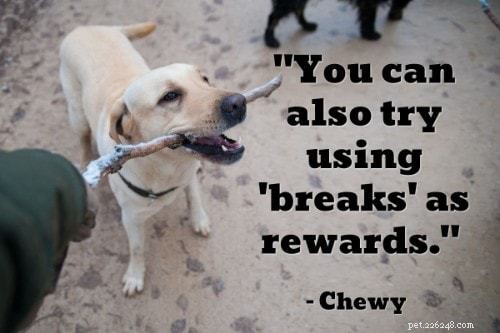
75. Rewards are more than just treats. “You can also try using ‘breaks’ as rewards. For instance, if (or, more likely, when!) he wants to sniff around, ‘Ask for a sit or eye contact first, then let him sniff and ‘be free’ for a bit, before walking nicely again,’ advises Mayer.” – How to Leash Train a Dog , Chewy; Twitter: @Chewy
76. Don’t start to early and don’t skip the home training. “I recommend waiting until they’re 10 weeks old. This is because until 12 weeks old, they’ve no need for ID tags as they’re just too young to take outside further than your back yard while they complete their vaccination program. And during house training you don’t need to lead them outside, they’re so small at this age that you can simply scoop them up and carry them. But by getting them used to a collar and leash at 10 weeks old, they will be comfortable wearing them by 12 weeks when you can start to walk them outside.” – LTHQ, How To Get Your Puppy Used To A Collar And Leash , Labrador Training HQ; Twitter: @LabTrainingHQ
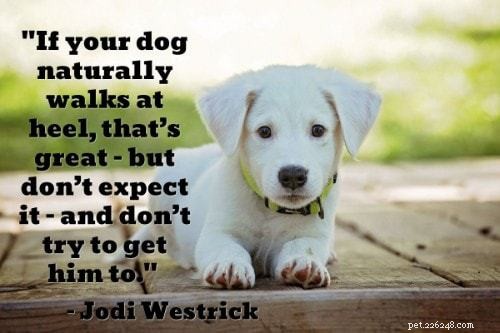
77. Get down to his level. “If your dog naturally walks at heel, that’s great – but don’t expect it – and don’t try to get him to. Yanking on the leash won’t help the situation, so think of getting him to walk as a gradual process. You may need to stand still or kneel down while he figures out what’s going on – that way your pup realizes that he won’t be able to go anywhere unless it is by your side. Some dogs may decide to sit down and not move. If this happens, call to your pup and offer him a reward when he comes over. Never yank him toward you. Once he comes over of his own will, offer him a treat and continue walking with him by your side.” – Jodi Westrick, How to Leash Train Your Active Puppy , Animal Planet; Twitter: @AnimalPlanet
78. Imposing penalties. “Here’s a terrific exercise. Set up a goal for your dog – it could be a biscuit on the ground, or a person she adores. With your dog on leash, take a step toward her goal. The instant she draws forward and tightens the leash, say, ‘Oops!’ and go right back to the starting point. Repeat, repeat, repeat, imposing penalty yards whenever your dog draws the leash tight. I did mention you’d need patience, didn’t I? Help your dog succeed by delivering treats as she keeps the leash loose on the way to the goal.” – Jolanta Benal, Teach Your Dog to Stop Pulling the Leash , Quick and Dirty Tips; Twitter: @quickdirtytips
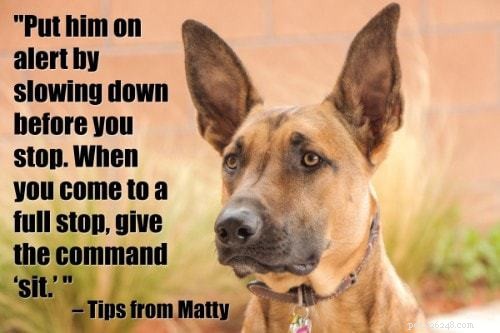
79. Don’t forget to teach him to sit at your side when you stop. “The procedure for teaching your dog to automatically sit when you stop walking is a simple one. Put him on alert by slowing down before you stop. When you come to a full stop, give the command ‘sit.’ If necessary, slowly pull us on the leash and push down on his haunches. […] When he does sit, praise him for obeying. Eventually, it will not be necessary to use the ‘sit’ command.” – Tips from Matty, Teaching your Dog to Heel and Sit , PBS; Twitter: @PBS
80. Repeat, repeat, repeat – and you’ll get it. “To make sure that your canine has the leash and collar routine down pat, you need to repeat this training in many different settings, and at many different places. Fortunately, leash training isn’t the most difficult dog training trick you’ll have to teach your dog, and it’s fairly easy to get ahold of this. You can even combine leash training with ‘stranger’ training. Just make sure you do them separately in the your home first.” – Samantha Randall, 3 Tips to Effectively Leash Train Your Dog , Daily Treat; Twitter: @RoverDotCom
Check Out These Resources and Products for Leash Training Your Puppy:
- How to Leash Train a Puppy:Iams® Puppy Training
- Little Dog – Leash Walking
- Leash Training
- How to Train Your Dog to NOT PULL on the Leash!
- Managing a leash-reactive dog
- 10 Quick Tips for Leash Training Your Dog
- The Best Collars and Leashes for Puppies and Dogs
- How to Give Your Dog a Good Leash on Life
- Whole Dog Journal Guide To Collars &Leashes
- Dog Leash Training eBook
- DOGS UNLEASHED:From On-Leash To Off-Leash:Complete Leash Training for Dog Lovers (New Dog Series)
- Puppy Leash Training Instruction:How to Train a Puppy to Walk On a Leash
- Dog Training:Leash Training, Potty Training, Crate Training And Behavior
- Let’s Go!:Enjoy Companionable Walks with your Brilliant Family Dog (Essential Skills for a Brilliant Family Dog)
Puppy Clicker Training
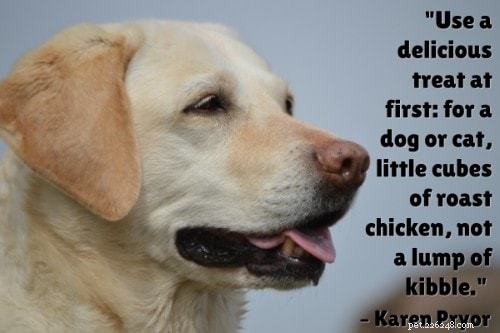
81. Know the proper clicker training procedure. “Push and release the springy end of the clicker, making a two-toned click. Then treat. Keep the treats small. Use a delicious treat at first:for a dog or cat, little cubes of roast chicken, not a lump of kibble.” – Karen Pryor, Fifteen Tips for Getting Started with the Clicker, Karen Pryor Clicker Training; Twitter: @karen_pryor
Check out our list of the Best Dog Training Treats for the perfect treats to use for clicker training.
82. A clicker isn’t a remote. “Do not point it at your dog. Instead put your hand behind you back or keep it to your side and click whenever your pet is doing the right thing. Dogs are visually oriented animals, this means that they will use any body cue you give them. You want them to respond to the ‘sound’, not your arm movement!” – 23 Free Dog Clicker Training Tips for Best Results , Dog Training Excellence; Twitter: @DogExcellence
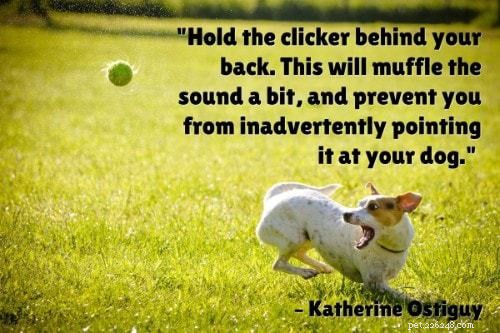
83. If the clicker scares your dog, find a way to soften it. “Hold the clicker behind your back. This will muffle the sound a bit, and prevent you from inadvertently pointing it at your dog. (Remember, it’s not a remote control!) If that’s not enough, you can wrap the clicker in layers of soft fabric to muffle the sound even more. One of my clever clients wrapped her clicker in baby socks. Every few days, she could take one sock off, so the sound gradually became a bit louder. It worked perfectly! After a couple of weeks, they were able to take the socks off the clicker and click ‘normally.’ You can also try these techniques with a ‘clicky pen‘ (one with a button on the end that you have to ‘click’ to start writing and ‘click’ to stop) and see if your dog is more tolerant of that. If she is, use that for the first couple of weeks and then reintroduce the clicker.” – Katherine Ostiguy, Fear of the Clicker:How to Train Your Dog Through It , Spring Forth Dog Academy; Twitter: @springforthdog
84. Start by charging up the charger with you dog. “Click the clicker once (in-out) and give your dog a treat (press on the end of the metal tab that does not have the dimple). Hint:Use something your dog really likes at first. Small pieces of yummy food (dog cookies, hot dogs, cheese) are best because the dog can enjoy it and be ready for the next thing quickly. Repeat this until your dog reacts to the clicker (by startling, pricking her ears, or suddenly looking for the treat). If she does, you’re ready for the next step… Hint:Try to keep your timing random (1-5 seconds between one click-and-treat time and the next). Technical Note:This is called ‘establishing a secondary reinforcer’ but most people call it ‘charging up the clicker’! Remember, click first, then treat.” – Stacy Braslau-Schneck, Get Started With Clicker Training, Wag’n’Train
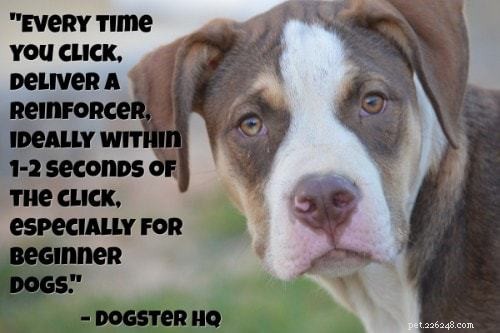
85. Treats mean reinforcements. “Every time you click, deliver a reinforcer, ideally within 1-2 seconds of the click, especially for beginner dogs. Think of the clicker like your dog’s paycheck – clicking without treating is like having your paycheck bounce at work…would you go back to work on Monday?” – Dogster HQ, Dog Clicker Training Basics , Dogster; Twitter: @dogster
86. Work on your timing. “Much of clicker training is mechanical skills, such as food delivery and clicker timing. You can work on improving your timing and accuracy without your animal. For example, watch the news and try to click whenever anyone says the word ‘today.'” – Mary Hunter, 10 Tips to Improve Your Clicker Training, Stale Cheerios; Twitter: @cheeriotrainer
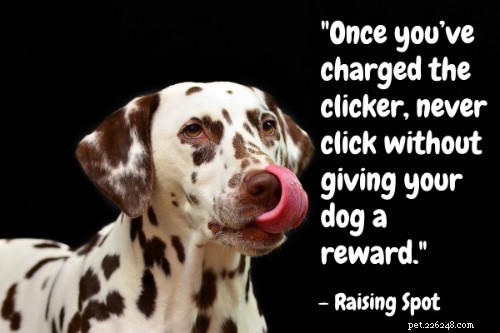
87. Every click is a treat. “Once you’ve charged the clicker, never click without giving your dog a reward. Clicker training depends on your dog trusting that a reward will come when he hears the marker. If you’re inconsistent, your dog won’t make an effort to remember the behavior that prompted the click.” – Tips for Successful Clicker Training , Raising Spot
88. The clicker is an audible alert letting your puppy know what’s coming. “So the clicker just lets your dog know that they did what you wanted them to do and it also lets them know that a treat is coming, because we’re going to be doing positive reinforcement training today.” – Clicker Training for Dogs:Wag! 2-minute Training Treats , The Daily Wagger; Twitter: @WagWalking
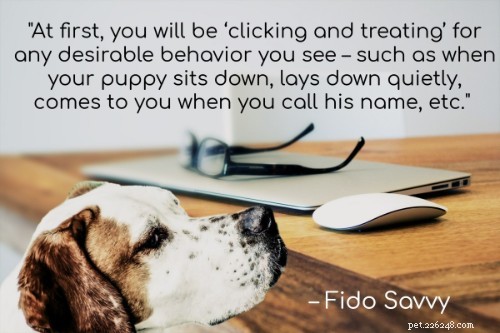
89. In the beginning, click for everything. “At first, you will be ‘clicking and treating‘ for any desirable behavior you see – such as when your puppy sits down, lays down quietly, comes to you when you call his name, etc.” – All About Puppy Clicker Training, Fido Savvy
90. Use clicker training consistently and your dog will be able to learn more. “Clicker training at the beginning is an example of classical conditioning. If used consistently it can become operational conditioning, where the dog intentionally repeats an action to gain a reward. The difference might seem minor but it has big implications on the behavior of your dog. If your dog is performing actions with a purpose rather than by habit he’s going to retain much more information.” – Jen Gabbard, How to Get Started With Clicker Training Your Dog , Puppy Leaks; Twitter: @puppyleak
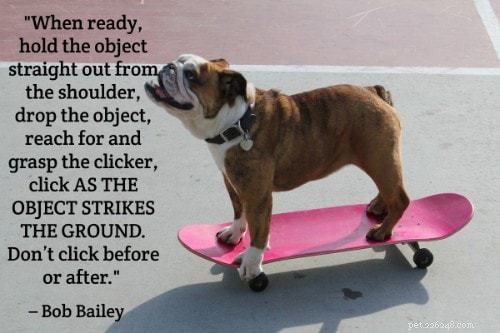
91. Practice makes perfect. “Stand next to a table. Place a clicker on the table where your right or left hand can reach it comfortably without your looking. Now, in your right or left hand (the one away from the clicker side), hold a bunch of keys, a ball, or some other fairly dense object. When ready, hold the object straight out from the shoulder, drop the object, reach for and grasp the clicker, click AS THE OBJECT STRIKES THE GROUND. Don’t click before or after. If you can, have someone else watch and judge your timing, or videotape. As a variation, when you get good (10 out of 10), begin to lower the dropping hand to shorten the time between release and hitting the floor. That is just a start. When you get that down pat, switch the hand that drops the object to the CLICKING HAND. Thus, if you click with the right hand, hold out the right hand with the object, drop it, reach with that same hand to get the clicker and click just as the object hits the ground. When you can do that 8 out of 10 times you are pretty good.” – Bob Bailey, Improving Timing , Clicker Solutions
92. Don’t speak. They know just what you’re saying. “One of the easiest things to start with is to teach them to touch an obvious target, like a mat on the floor, a ball on a stick or your hand. As your pet approaches the target, click and treat. You don’t have to wait until they touch it because you’re shaping their behavior and rewarding small steps towards the end goal. At this stage let the clicker speak for itself – if you say anything it could be distracting.” – Clicker Training Your Pet , Blue Cross for Pets; Twitter: @The_Blue_Cross
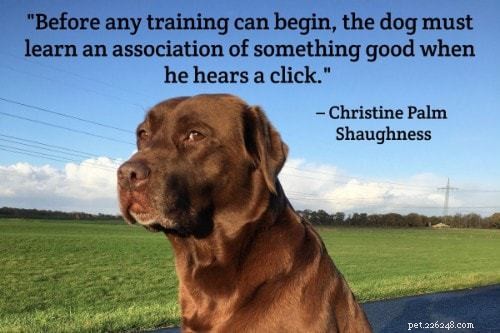
93. Keep charging your clicker during training. “One of the biggest problems with clicker training is the lack of understanding of why and how to use the clicker. I recently met a novice trainer who didn’t know that the clicker needed to be ‘charged,’ that is, before any training can begin, the dog must learn an association of something good when he hears a click. After all, the sound of the click by itself is meaningless. ‘Charging’ the clicker involves simply clicking and immediately giving the dog a high value treat. Click and treat, click and treat. Do this about 20-30 times. The dog is sure to learn that whenever he hears the click, it’s a good thing!” – Christine Palm Shaughness, Clicker Training for Dogs, Capers for Canines (and Other Animals)
94. Clicker training is so much faster. “An advantage to using the clicker is that the reward is instantaneous. You can press the clicker much more quickly than you can give the dog a treat or even say ‘good boy.’ As soon as the dog starts the good behavior, immediately click. That way, it’s completely clear to the dog what you are rewarding.” – Megan Smith, Clicker Training Pros &Cons , Daily Puppy; Twitter: @DailyPuppy
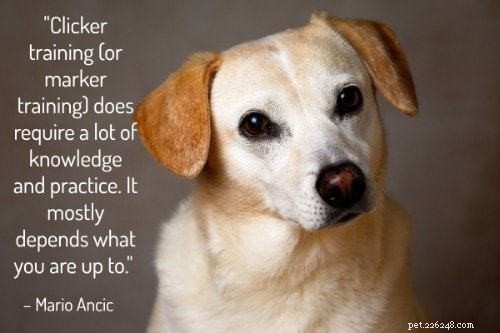
95. The more advanced the technique, the more skilled your clicking will need to be. “Clicker training (or marker training) does require a lot of knowledge and practice. It mostly depends what you are up to. With basic exercises you can get away with not such great timing, however with more advanced exercises it is important that you have a good eye-hand coordination.” – Mario Ancic, Pros and Cons of Clicker Training , Training Your Dog and You
96. Don’t ignore any bad behaviors during clicker training. “How to eliminate behaviors you don’t like:Establish a ‘no reward’ signal, like ‘oops’ or ‘too bad.’ Positively reinforce an incompatible behavior (a reliable ‘sit’ will prevent your puppy from jumping up). Time-outs:Immediately after a misbehavior, turn away and ignore the puppy for 30 seconds to a minute.” – Clicker Training – First Steps , Animal Hospital of North Asheville; Twitter: @AHNApets
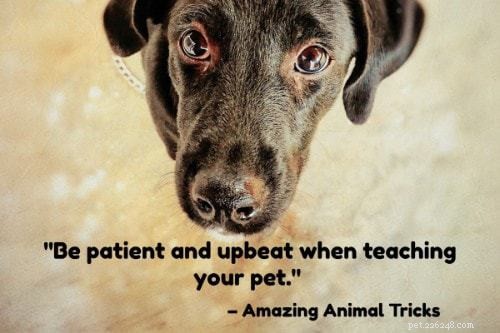
97. Click even for small progress. “Click when the animal offers small steps in the right direction. Animals learn most behaviors in small steps; they do not have to perform the behavior perfectly at first. Be patient and upbeat when teaching your pet.” – Clicker Training, Amazing Animal Tricks
98. Transitioning away from food rewards. “What many people do not realize about dog clicker training is that the ultimate goal is to be able to get certain behaviors from your dog reliably without having to have a clicker and a treat bag in your hand. It is important to learn how to transition away from dependence on the clicker system once a behavior is learned and you have added distance, duration and distraction. […] Return to a food reward refresher from time to time:This helps keep your dog sharp on behaviors that you have trained. There is no harm in practicing well known behaviors with a rapid reward in the context of a training session. This will only help your dog stay confident in a training session as well as keep them sure about commands they learned long ago.” – Mat, Clicker Training Basics 7 Insanely Actionable Steps , Wiley Pup; Twitter: @wileypupwebsite
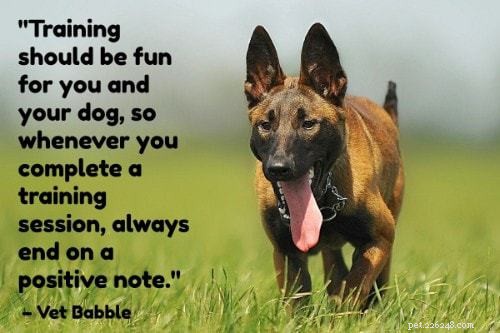
99. End on a high note. “Training should be fun for you and your dog, so whenever you complete a training session, always end on a positive note. If you are both getting frustrated, ask your dog to do something he knows how to do and reward him for that. Never end on a failure. The following video has some great training advice and features the clicker and how to shape behaviors.” – Cool Dog Tricks To Teach Your Furry Friend , Vet Babble; Twitter: @VetBabble
100. Worst case scenario is it won’t work if not done properly. “Clicker training is recommended by the American Veterinary Society of Animal Behavior as well as the Humane Society of the United States. There are no negative side effects. The worst that can happen is training will be ineffective if applied incorrectly.” – Clicker Training Basics , Fortunate Fido
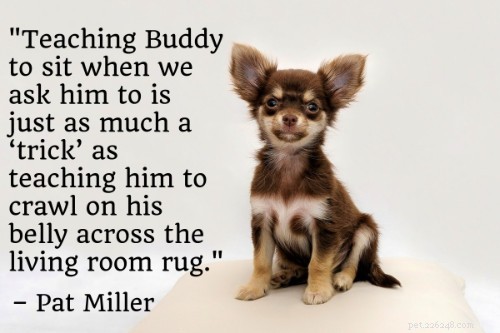
101. It’s all tricks! “Positive trainers have a saying that I love. We like to remind our clients that, ‘It’s all tricks!’ Teaching Buddy to sit when we ask him to is just as much a ‘trick’ as teaching him to crawl on his belly across the living room rug. They are both simply behaviors that Buddy is physically capable of doing, that we teach him to offer us in response to a verbal cue or hand signal. If we can change our attitude and remember to have fun teaching the basics as well as the tricks, we can have a dog who performs the serious behaviors with just as much enthusiasm as he does when he rolls over or catches a treat off the end of his nose.” – Pat Miller, Clicker Training and Trick Training Your Dog , Whole Dog Journal; Twitter: @WholeDogJournal
Need more training advice? Make sure to check out our helpful pet training articles.
Check Out These Resources and Products for Clicker Training your Puppy:
- The Wonder of Clicker Training:The Complete Guide to a Nonviolent, Positive, Compassionate, &Effective Way of Dog Training with Clickers
- Understand THIS and Your Dog Will Learn Faster (How to Achieve Perfect Timing!)
- Clicker Training 101
- Super Cooper Sunday #2 – Clicker Training Explained (Golden Retriever Puppy)
- Best Pet Clicker Trainers
- Clicker Training for Dogs
- Is There Something Special About Clicker Training for Dogs?
- Clicker Training Dogs
- Clicker training – Wikipedia
- Clicker Training for Dog Lovers
- A Simple Guide on How to Train Your Dog:Use Clicker Training to Teach Your Dog to Walk on a Leash, Sit, Stay, Go to Potty and Obey Your Commands
- EcoCity 2018 Pet Training Clicker Set (4 Pack)